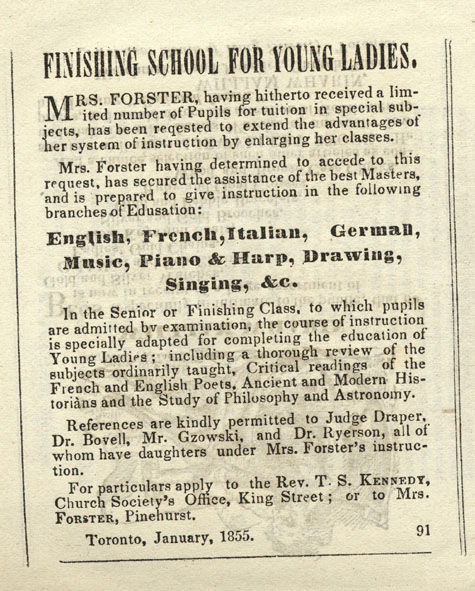
___________________________________________
A book written in 1854 by Catharine Paar Traill’s, “The Female Emigrant’s Guide, And Hints on Canadian Housekeeping” identifies what it takes to prosper in Canada as a female emigrant. An advertisement, found in the back of Traill’s book is titled, “Finishing School For Young Ladies”. As the society shifts from traditional female roles finishing schools are offered to young ladies. Expanding classrooms and subjects suggests that not only is the population increasing but the social norms of women is evolving.
Based on the document, we can infer that finishing schools were private schools that were geared towards wealthy young women to prepare them for society. Pinehurst Finishing School was a private school for young ladies located somewhere near Toronto, Ontario. Some commonly taught courses in our current curriculums are being advertised as new branches of education in the mid nineteenth century. This allows us to believe that finishing schools likely concentrated on stereotypical social graces and cultural etiquette for women were common in this time period. We can determine, that this finishing school in particular is more prestigious than the rest. As it mentions, the inclusion of academic subjects not “…ordinarily taught…” in other finishing schools.
This advertisement’s audience would be primarily white wealthy females living in the Ontario area of pre-confederation Canada during the mid nineteenth century. The advertisement is addressing that both, class sizes and subjects offered are expanding. As stated in the article, “Mrs.Forster having hitherto received a limited numbers of pupils for tuition in special subjects, has been requested to extend the advantages of her system of instruction by enlarging her classes.” It is apparent from this document they are expanding their class sizes and offering more classes to females. Population increase would be one of the main cause for the demand of expanding classrooms. Additionally, part of the finishing school curriculum, is to help young ladies obtain husband’s which would result in more people settling and increased population through reproduction. It is apparent that there are a lot of wealthy colonial women settling in this area generating a high demand for education during this time.
During the early nineteenth century women typically stuck to more conventional domestic chores and having any sort of extra education would be viewed as useless. Society essentially presumed that women might not have had the intellect to commit to demanding educational courses.The academic subjects being offered at this finishing school suggests that women are starting to evolve out of the traditional roles of the household. The subjects offered to the young women were English, French, Italian, German, music, piano & harp, drawing, singing, philosophy and astronomy. This was a stepping stone for higher education and knowledge to be viewed as an integral component for women in early Canada.
In contrast, this advertisement still shows some evidence that men were heavily involved in women’s education. It is apparent from the that men were majorly associated with the finishing school and who was accepted. As stated in the article, “References are kindly permitted to Judge Draper, Dr.Bovell, Mr.Gzowski, and Dr.Ryerson, all of whom have daughters under Mrs.Forster’s instruction.” Typically, during this time period doctors and judges were primarily men. It appears that men exclusively had the power to decide which ladies could enroll in Pinehurst Finishing School. Therefore, women still have a long way to go in regards to evolving from societal norms.
The purpose of this advertisement was to give information to wealthy young women in regards to the finishing school. What is concluded from this document is that the population is increasing and so is the need for wealthy educated women in the society. Cultural norms for women in the household still exist but the acknowledgement for higher education is present.
Notes
- Unknown, “Finishing School for Young Ladies”, Toronto, 1855 (91). Found in A book written in 1854 by Catharine Paar Traill’s, “The Female Emigrant’s Guide, And Hints on Canadian Housekeeping”
- Ibid.
- Ibid.